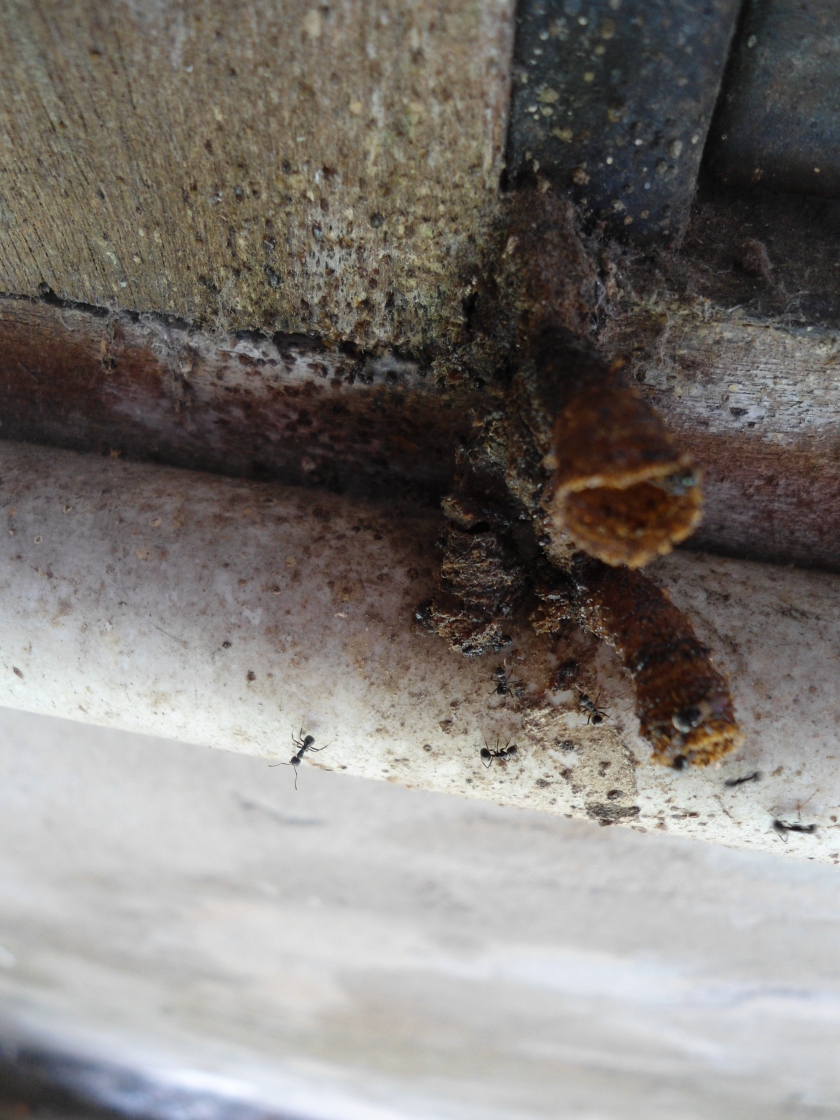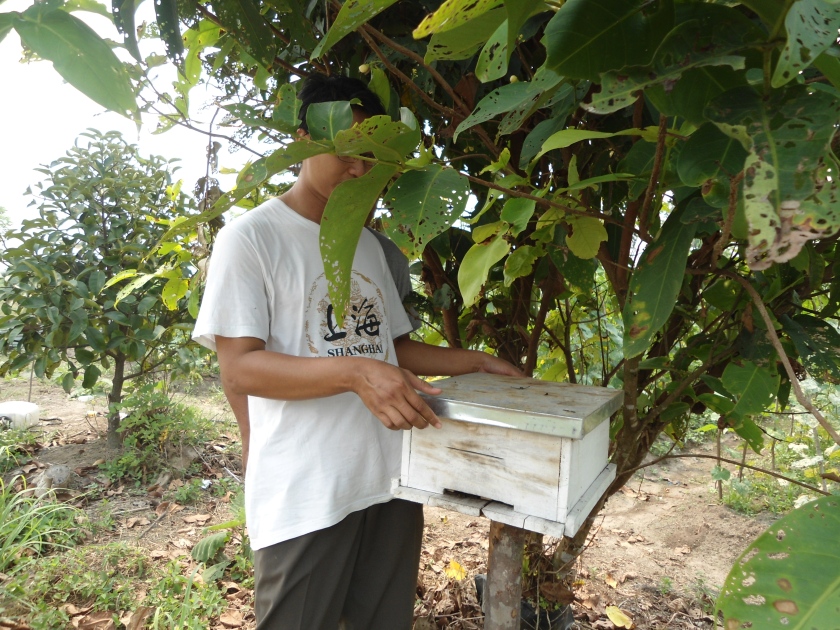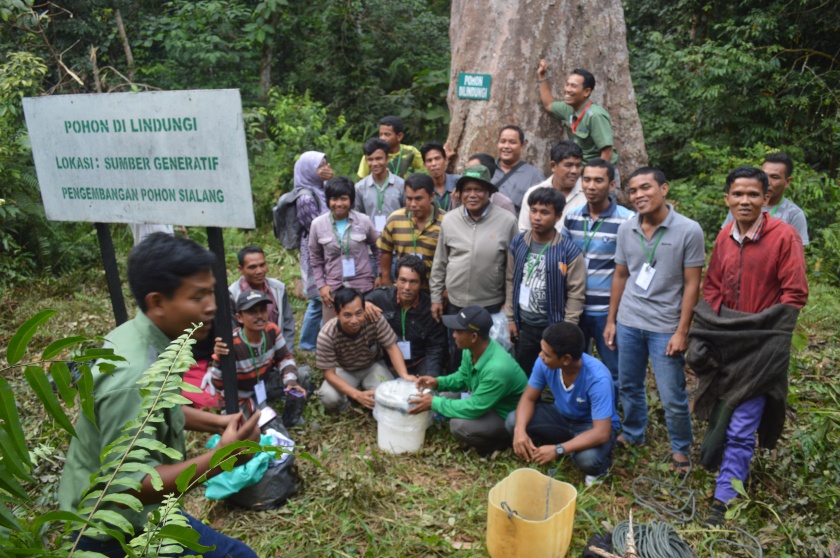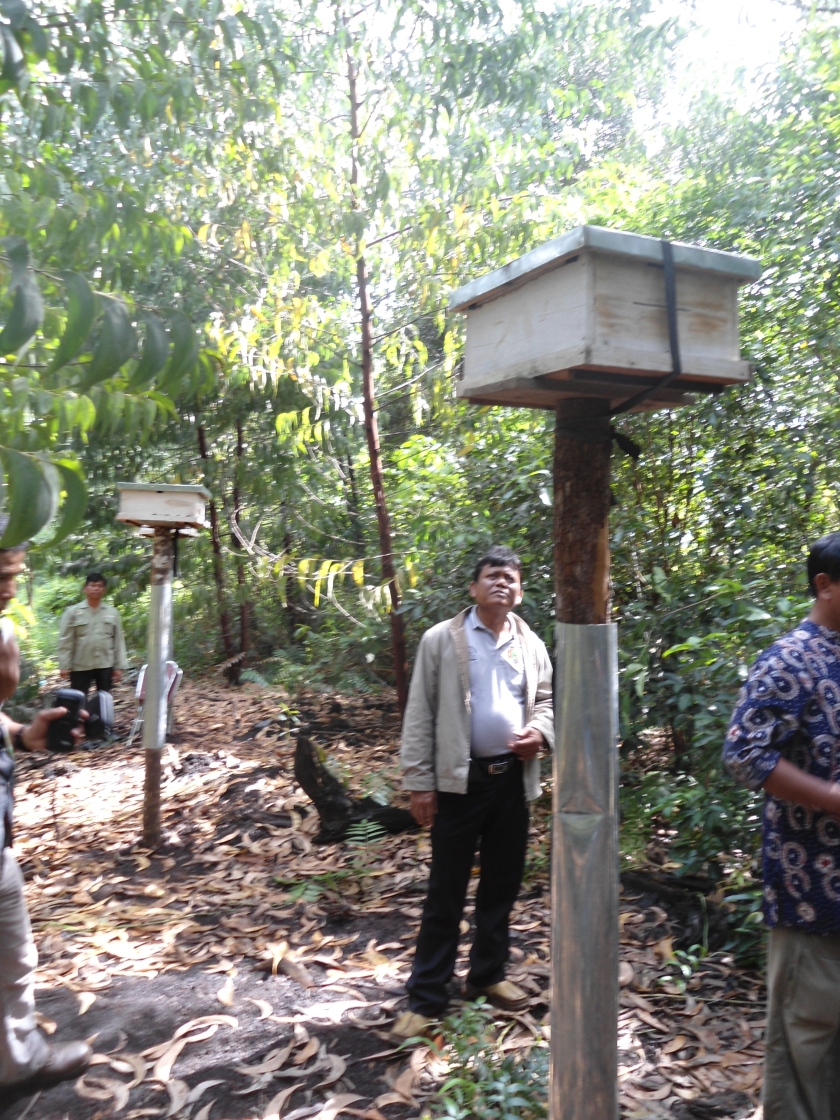By Avry Pribadi
Introduction
Insect colonies, although composed of many individuals, it has function in a manner like individual organisms. Many insect species, including bees and ants, work together in colonies, and their cooperative behavior influences the whole colony member survival (1). For many years, this type of interaction has been associated to that of a single organism, which every individual in a colony acts and cooperates each other like a cell in the body of high-level organisms, such as mammals. This term for this phenomenon is called superorganism. Definition of superorganism is mostly used in describing a social unit of eusocial insects, where labor division is highly specialized and where every individual are not able to survive and very dependent by themselves for extended periods. Ants and bees are the best-known examples of such a superorganism. A superorganism can be described as a collection of many agents which can act in concert to produce phenomena managed by the collective (2) phenomena being any activities such as collecting food, caring for brood, and avoiding predators (3) choosing a new nest site (4). Moreover, superorganisms can also exhibit homeostasis, power law scaling, and emergent behaviors.
As superorganism, honey bee, in which categorized as eusocial insect, has led to fundamental changes, including increasing system of communication complexity as well as more frequent contacts among individuals (1). Even though superorganism is success in evolution and exhibits better communication within organism, this regular contact sometimes makes many problems in their life because it will provide proper conditions to increase the probability of pest and diseases spread between colony member. Furthermore, it is not only about high concentration of colony`s member, but also their nests provide microhabitats where parasites and pathogens find favorable humidity and temperatures along (P. Schmid-Hempel 1998 cited in (5)). As a result, natural selection has generated physiological, anatomical, and behavioral adaptations in social insects to minimize the negative impacts of parasites and pathogens (6). One of the mechanism is called social immunity.
The first definition of social immunity is conveyed by Sylvia Cremer in 2007 that mentioned that social immunity is altruistic behavior or collective action of infected individuals that give more benefit to their colony (7). This definition focused on the behavior of collective assistances and when describing immune phenomena which were depending on the multiple actions of many individuals within colony (7). Social immunity phenomenon encompassed the nature of these defenses that they cannot be presented efficiently in single individuals. However, this mechanism depends exactly on the cooperation of at least two individuals (8). Moreover, in 2010, Sheena Cotter and Rebecca Kilner (University of Cambridge) suggested to expand the social immunity definition to become any types of immune response that have been designated to increase the fitness of the challenged individual and more recipients and described as collective immunity (8). It has been proposed for many years that the social immunity evolution can be seen as one of the major transitions in evolution. Joël Meunier (University of Mainz) recommended a thought that social immunity in the context of evolution of group living has relationship to personal and collective mechanism that has emerged and/or maintained at least because of the anti-parasite defenses (2).
Similar to all animals, every individual in social insect has immunological and physiological defenses against pest and disease agents (Schmid-Hempel 2005 cited in(5)). Nevertheless, beyond the individual immunity, social insects also show many physiological, behavioral, and organizational colony-level adaptations. Social insects reveal the fact to be many to show collective behavioral defenses accomplished by all group members cooperation, collectively avoiding, and removing parasitic infections (9). Many different mechanisms give to these social immune defenses mates. Meanwhile, others are activated on demand once pathogens are already established in the colony. Because this phenomenon is very interested, this paper is trying to find out how social immunity works social insects.
Social immunity strategies
Antimicrobial secretions produced by colony members or even taken from environment are the first collective defenses strategy (10). Bees and ants sometimes sterilize their nest by using antimicrobial substances. For instance, Formica paralugubris uses coniferous trees resin to coat their nest (11) or Trigona itama collects propolis from Mangifera indica and Agathis sp. In bees and wasps, the social evolution was followed by the evolution of stronger self-made antimicrobial substances which significantly increase in effectivity equal to group size enlargement of group size (12). Meanwhile, in ants, antiseptic ant antifungal substances are produced in the metapleural glands(13). In addition, termites secrete antimicrobial substances from their fecal pellets and from soldier frontal glands.
The nest strategy is collective antimicrobial behavior. In honey bees, they will behave to increase the comb temperature, that is initiated by adult bees, in response to infestation by Ascosphaera apis. This behavior uses to preventing disease development (14). This grooming behavior (an individual groom or nestmates groom) is another essential defense mechanism against parasites and pathogens widespread in all social insects. Undertaking and hygienic behavior are specific types of nest hygiene behavior which honeybees can detect and then remove parasites from the nest. Meanwhile, other behavior, namely waste management behavior, aimed to maintain nest chambers keep clean. This unique behavior is exhibited by cavity-dwelling species, such as termites and ants species (15). The other extreme behavior is shown by Temnothorax that perform altruistic behavior. Workers that are infected by entomopathic fungus are willing to leave their colony (16) and deformed workers in honey bees will crawl out of the hive (17).
The third strategy is organizational immunity that describes how the social organization inside nest will do interaction with epidemiological variables to create different categories of pathogen transmission (18). It is known that in honey bees and ants from different group of workers (with the similar morphological caste or age) perform similar tasks within nest organized in a centrifugal polytheism. In the inner area of the nest, which is filled with the brood, the younger workers and the queen are behaviorally and spatially segregate from older workers. The queen is cared and feed by young workers, meanwhile, older workers are mainly in outside the nest for forage or even in the nest corner for dead bodies and garbage disposal of dead bodies and garbage.
Steps in managing parasites invasion in social insects.
Parasites cause damage to social insect colonies. Parasites can either actively search for or enter the colony, or even be picked up and transported into the colony by host individuals by incidentally. Afterward, the parasite infections can be transmitted between individuals. There are some terms for spreading the parasites. The first is vertical transmission which means that parasites are transmitted from parent to offspring. The second is that parasites transmission between individuals from same generations or called horizontal transmission. In many cases, parasite invasions into a colony involve multistep process. To infect a social insect colony, parasites have to be taken from the outside environment (parasite uptake) which is commonly coming from food resources and brought to the colony (parasite intake). Next, parasites then have to develop and grow in the internal environment within colony, and then it will spread among group members. On the other hand, parasites transmission between two group members happens when infectious individuals do contact with the infected and the uninfected individual. The next step, after infection of the focal group, parasites can move to other groups either by horizontal or even vertical (19).
This parasites infestation should be anticipated and managed by social insects. Social insects can interfere at each of steps in parasite infection. Host defense performance might be controlled by the colony’s life ecology and history (20). For instance, bees forage on flowers whose availability changes spatially and temporally and which moreover cannot be dominated by a single colony. Different to ants, who defend their feeding territories around their nest, bees are not able to avoid sharing feeding sites with other colonies, although flowers often being source of infections. Because of social insects work as collective, it means that they will anticipate and manage all the parasites attack together by many following mechanisms.
The first and second step are decreasing parasite uptake and intake. Several infections in social insect groups not only happen vertically from mother group but also come from the outside (horizontally). If parasites enter the nest actively, it will increase the infection risk depends on whether the nest is exposure to the external environment. For example, in some wasps and bees are covered within a special physical construction. Presumably, nest architecture construction evolution itself is constructed under selection by parasites (Schmid-Hempel, P. (1998 ) cited in (19). The other behaviors show in some ant species that try to hide from parasitic flies over ant foraging trail. This behavior aims to Vieira-Neto et. al. (2006) cited in (19). To inhibit parasites intake, colonies are sometimes expected to limit the entrance to parasites or infected incoming foragers. In honeybees, they have guard bees that always control the nest entrance and, together with the other workers (if necessary) send out their infected nest mates (21).
If the first and second step is not working to protect the parasites attack or even parasites are transmitted by vertical ways, the social insects will develop the next step (third step) which is trying to prevent parasites establishment inside the nest. The colony will enlarge their hygiene capacity to reduce parasites accumulation over time, especially for social insects nesting in soil (20). Social insects have mechanism to sterilize their nest material with antimicrobial materials that are collected from the environment or even self-produced. For example, wasps produce antimicrobial substances from their venom glands that stick to the walls of the hibernation sites to protect the next generation of wasps visiting the same hibernation site (Turillazzi et. al. (2006) cited in (19). Meanwhile, in stingless bee (Trigona itama), they collect resin and use that resin to cover all of nest parts such as honey and pollen pot, brood cell, and entrance door as well. Even, T. itama will cover alien substances that come to their nest, such as leaves, with resin.
A significant risk of infection probably comes from nest mates that have died from an infection within the colony. To overcome this problem, bees, termites, and ants will quickly remove this dead body from their nest Epsky, N.D., and Capinera, J.L. (1988) cited in (19), task that is often done by specialized workers. For instance, some termites bite the legs off the corpses of their infected nest mates. This activity will kill infectious parasite stages by using desiccated method (23). The other phenomenon happens in Apis cerana when their nest mates attacked by Varroa sp.; uninfected bees will help to pick the mite from infected bees. Meanwhile, in T. itama, workers will make a waste dump collection (include their nest mates dead body) inside the nest before they throw it away from the nest.
The fourth stage is by reducing parasite spread within colony. Even though, there are many mechanisms above that can be used to prevent parasites infestation, yet, parasites still can find many ways to become established in the nest. Thus, in this case, more efforts need to be done to prevent the parasite from spreading among group members. How the healthy individual becomes infected is a function of the infectiousness of the infected individual. There three factors that determine this matter, i.e. (1) the number of infectious propagules that can be transferred to their nest mates, (2) its contact rate and the type of interaction with non-infected individuals, and (3) the non-infected individual’s susceptibility.
A social insect colony is often organized into spatial and behavioral. These organizations consist of workers that show similar tasks. Distribution of workers who have job to dispose of dead bodies and garbage takes place at the edge or outside of the nest (upper left corner). Thus, it shows that these workers do not have direct contact with the main nest. Fatal and non-critical infections can have three levels of severity: i.e. (1) lowest level when the infection is limited (like what happened garbage and forager workers), (2) intermediate level when the infection spreads within the peripheral nest area which dominantly occupied by old workers, and (3); highest level when the parasite have reached the center of the nest, where nurse bees and brood can be infected (d). The infection is fatal when the queen itself becomes infected (24).
To anticipate this problem, honey bee colonies have developed defense mechanisms to reduce and stop the infection spread. First, the guard bees will guard the colony entrance from infected garbage dump workers and parasite infected foragers. If this mechanism does not work or when the infection has extended to the nest, the transmission line to other individuals within the nest can be destroyed by reducing social contact (absence of interacting contacts) (24). Infected brood can be taken away from the colony. Meanwhile, the queen, the very important individual in nest are intensively nursed by workers that will give hygienic treatments, such as grooming, where infectious propagules are taken away from the body surface (19). Afterward, the social organization of the colony can be kept flexible and adjusted to probability next incoming parasites.
The last mechanism is by reducing potency of vertical and horizontal parasites transmission. Once a parasite has propagated inside a colony, it can be passed easily on to other group members, such as neighbor colonies and daughter colonies. Colonies can be infected by when queens lay infected brood or even accompanying workers and daughter queens obtain an infection by either vertical or horizontal transmission before leaving the parental colony. Selection efforts to avoid vertical transmission to their daughter colonies must be strong. It happens because the colony fitness depends on the next offspring production. Consequently, workers try to do the best practices to survive all their offspring. The behaviors, such as stop assisting queens when they get infected Wang, D.I., and Moeller, F.E. (1970 cited in (19) and covering brood cell with antimicrobial substances (Beattie et. al., 1986 cited in (19), have objective to avoid infection of daughter colonies. Other examples is ant queens that coat their eggs with poisons liquid which decrease fungal infections (25).
Conclusion
Like in high-level animal, such as mammals, social insects reveal their ability as superorganism to anticipate parasites attack almost similar to what happen in mammal. Social insects have evolved complex social immune systems. Social immune system in social insects forms functional barriers at every step in parasite invasion by a prophylactic combination and activated responses, such as physiological, behavioral, and spatial mechanisms. Generally, there are some stages for social insects to practice their social immunity, e.g. (1) decreasing parasites uptake and input, (2) inhibiting parasites development inside the nest, (3) reducing parasites distribution within nest and colony members, and (4) decreasing possibility of parasites to transmit in vertical and horizontal ways. A better social immunity of understanding might even lead to the reconsideration of the evolution of host behaviors that have previously been proposed to be the result of parasite manipulation, such as infected individuals that leaving the nest.
List of references
- Bourke, A.F.G. Principles of social evolution. Oxford, UK: Oxford University Press; 2011.
- Kelly, K. Out of control: the new biology of machines, social systems, and the economic world. Boston: Addison-Wesley.; 1994.
- Deneubourg, J.L. The Self-Organizing Exploratory Pattern of the Argentine Ant. J insect Behav. 1989;(3):159–168.
- Britton, N.F. Deciding on a new home: how do honeybees agree? Proc R Soc B. 2002;(269):1383–1388.
- Tarpy, D.R., and Seeley, T.D. Lower disease infections in honeybee (Apis mellifera) colonies headed by polyandrous vs. monandrous queens. Naturwissenschaften. 2006;93(4):195–9.
- Seeley, T.D. Honeybee ecology: a study of adaptation in social life. Princeton: Princeton Univ. Press,; 1985.
- Meunier J. Social immunity and the evolution of group living in insects. Philos Trans R Soc B Biol Sci. 2015;370(1669):20140102–20140102.
- Britton, N.F. Deciding on a new home: how do honeybees agree? Proc R Soc B. 2002;(269):1383–1388.
- Cotter, S.C. and Kilner, R.M. Personal immunity versus social immunity. Behav Ecol. 2010;21(4):663–8.
- Sadd, B.M, and Schmid-Hempel P. Insect immunity shows specificity in protection upon secondary pathogen exposure. Curr Biol. 2006;16(12):1206–10.
- Christe, P., Oppliger, A., Bancalà F., and Castella, G., and Chapuisat, M. Evidence for collective medication in ants. Ecol Lett. 2003;(6):19–20.
- Turnbull, C., Hoggard, S., Gillings, M., Palmer, C., Stow, A., and Beattie, D. Antimicrobial strength increases with group size: implications for social evolution. Biol Lett [Internet]. 2011 Mar 11;7(2):249 LP-252. Available from: http://rsbl.royalsocietypublishing.org/content/7/2/249.abstract
- Holldobler, B. and Wilson, E.O. The Ants. New Jersey: Springer-Verlag; 1990.
- Starks, P.T, Blackie, C.A., and Seeley, T.D. Fever in honeybee colonies. Naturwissenschaften. 2000;87(5):209–31.
- Bot, A.N.M., Currie, C.R., Hart, A.G., and Boomsma, J.J. Waste management in leaf-cutting ants. Ethol Ecol Evol [Internet]. 2001 Jul 1;13(3):205–37. Available from: http://dx.doi.org/10.1080/08927014.2001.9520772
- Heinze, J., and Walter, B., Moribund ants leave their nests to die in social isolation. Curr Biol. 2010;20(3):249–52.
- Rueppell, O., Hayworth, M.K., and Ross, N.P. Altruistic self-removal of health-compromised honey bee workers from their hive. J Evol Biol. 2010;23(7):1538–46.
- Naug D, and Smith B. Experimentally induced change in infectious period affects transmission dynamics in a social group. Proc Biol Sci [Internet]. 2007;274(1606):61–5. Available from: http://www.pubmedcentral.nih.gov/articlerender.fcgi?artid=1679870&tool=pmcentrez&rendertype=abstract
- Cremer, S., Armitage, S.A.O., and Schmid-Hempel P. Social Immunity. Curr Biol. 2007;17(16):693–702.
- Boomsma, J.J., Schmid-Hempel P., and Hughes, W.O.H. Life histories and parasite pressure across the major groups of social insects. ,. In Insect Evolutionary Ecology. M. Fellowes, G. Holloway, and J. Rolff, eds. (Wallingford: CABI),; 2005. 139–175 p.
- Drum, N.H. and Henbuhler, W.C. Differences in on- stinging aggressive responses of worker honeybees to diseased and healthy bees in May and July. J Apic Res. 1985;(24):184–187.
- Wilson-Rich N., Stuart, R.J., and Rosengaus, R.B. Susceptibility and behavioral responses of the damp wood termite Zootermopsis angusticollis to the entomopathogenic nematode Stei- nernema carpocapsae. J Inv Pathol. (95):17–25.
- Meunier, J. Social immunity and the evolution of group living in insects. Philos Trans B R Soc. 2015;370:20140102.
- Siebeneicher, S.R., Vinson, S.B, and Kenerley, C.M. Infection of the red imported fire ant by Beauveria bassiana through various routes of exposure. J Inv Pathol. 1992;(59):280–285.

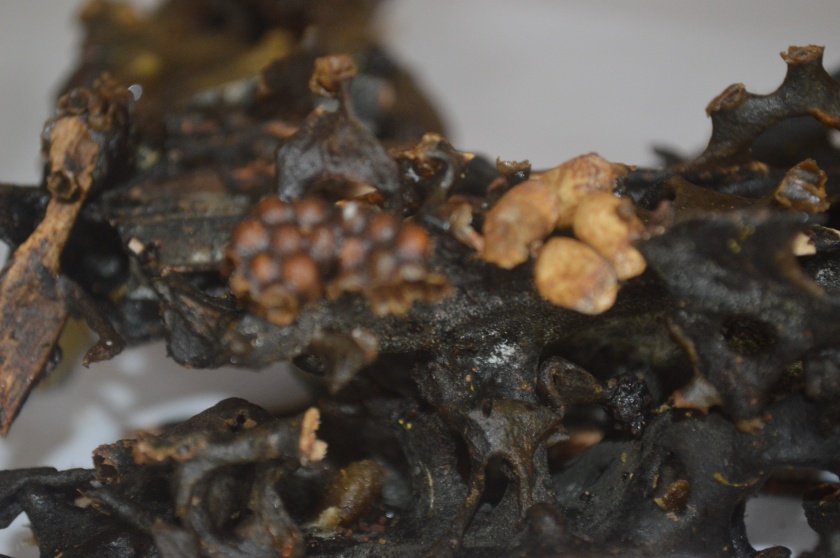 Queen cells of Trigona itama covered by black propolis
Queen cells of Trigona itama covered by black propolis

